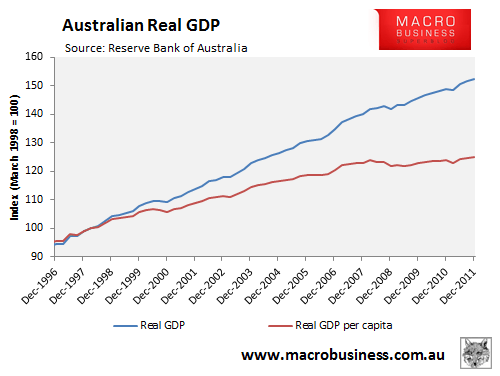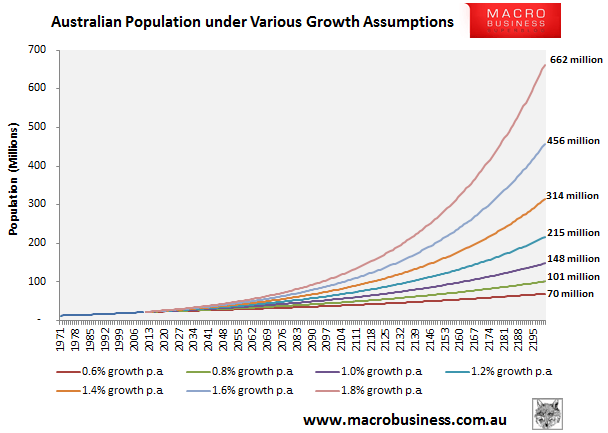
Meet Harry Triguboff. For those who aren’t aware, Mr Triguboff is also known as “High rise Harry” and is the head of Meriton. Meriton is the largest developer of apartments in Australia, with around 50,000 under their name.
In early 2010, Mr Triguboff declared his interest in a “Big Australia” when he commented that he would like to see Australia’s population reach 100 million:
“I don’t think there will be 35 million but about 55 million,” he said on The 7.30 Report.
Without population growth, Mr Triguboff says the economy will stall.
“I’d like to see 100 million, because I believe we will have many things to do here besides drilling holes and selling coal,” he said.
“Our agriculture has to be huge.
“Our desalination must be fantastic. Our rivers must flow the right way.
“It will all have to be developed.”
And yesterday, Mr Triguboff was at it again, arguing that Australia needed 500,000 immigrants each and every year in order to “repair Australia’s property market” and achieve a viable economy:
The migrant intake must grow by at least half a million people per annum. It is impossible to run a huge continent with 23 million people. It does not matter whether Prime Minister Gillard or Tony Abbott will rule the country. With migration rising there will be more need for accommodation and we must build more.
According to Mr Triguboff, it’s impossible to run Australia with a population of 23 million. I must ask: how many people would argue that the United States’ economy, with a population some 15 times larger than Australia’s (on a similar land mass), or China’s and India’s economies (each with some 1.2 billion people) are in a better position than Australia?
Hyperbole aside, below are four reasons why I believe that Mr Triguboff’s prescription does not stand up to a rigorous economic assessment and would not be in Australia’s interests.
First, from a narrow economic perspective, immigration is good only if it raises the real average incomes of the pre-existing population (e.g. GDP per capita). While it is true that Australia’s high population growth over the second half of the 2000s boosted Australia’s real GDP (more labour inputs, other things equal, means more outputs), there is little empirical evidence to show that GDP per capita increased due to population growth. In fact, as the below chart shows, real GDP per capita has flatlined since 2007. So while the economic pie has increased in size since 2007, because of high population growth, everyone’s share of that pie has not increased!

Second, Australia earns its way in the world mainly by selling its fixed mineral resources. More people means less resources per capita. A growing population also means that we must deplete our mineral resources faster, just to maintain a constant standard of living. This doesn’t sound like a smart approach to me.
Third, there are the serious costs of high population growth – including environmental degradation, water scarcity, increased pollution and congestion, lower housing affordability, and a greater need for costly new infrastructure investment (e.g. desalination plants). I do not hold much hope that these issues can be successfully managed given that Australia’s governments have failed so dismally in providing for the existing population, let alone millions of extra citizens. Further, it will be near impossible for Australia to reduce its carbon footprint and meet international pollution reduction targets with a substantially larger population.
Fourth, and more broadly, population boosters often argue that Australia needs to import more workers in order to cover the costs of an ageing population. However, the issue of an ageing population will need to be addressed at some point irrespective of the level of immigration. Simply importing more workers to cover the retirement of the baby boomers only delays the ageing problem, pushing the problem onto future generations. What will be the population boosters’ solution in 30 years time when current migrants grow old, retire and need taxpayer support? More immigration and an even larger Australia? In this regard, a “Big Australia” brought about by high immigration is just another ponzi scheme.
Finally, one of my biggest gripes with the whole population debate is that the population boosters fail to acknowledge that that we cannot have infinite population growth in a finite world. As an illustration, the below chart plots Australia’s population trajectory under various growth rate assumptions. Even at only 0.6% per annum compound growth – roughly one-third the current growth rate – Australia’s population would reach 70 million by the year 2200. Put your hands up if you think that Australia would be a better place with a population roughly three times its current size in a world experiencing severe constraints from depleted oil reserves, among other things?

While you might think that the above chart is facetious, as population growth could easily be curtailed at some point in the future, the fact remains that there will always be vested interests pressuring governments to expand population growth in the face of an ever-ageing population (see fourth point above).
Ultimately, it is living standards that matter most. And on this count, rapid population growth is a negative for Australia. That’s why views like Mr Triguboff’s should be taken with a tablespoon of salt.

